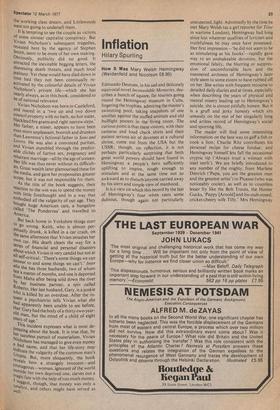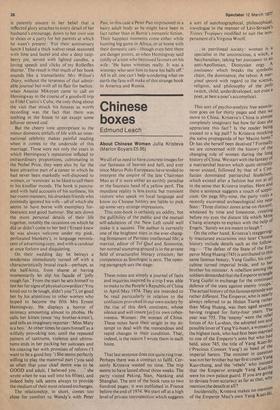Inflation
Hilary Spurling
How It Was Mary Welsh Hemingway (Weidenfeld and Nicolson £6.95)
Edmund() Desnoes, in his sad and delicately equivocal novel Ineonsolabk Men tories, describes a bunch of square, fat tourists going round the Hemingway museum in Cuba, fingering the trophies, admiring the master's swimming pool, taking snapshots of one another against the stuffed animals and old bullfight posters in the living room. The curious point is that these visitors, with their cameras and loud check shirts and their patient serious air of devotees at a cultural shrine, come not from the USA but the USSR; though, on reflection, it is not perhaps particularly surprising that both great world powers should have found in Hemingway a people's hero sufficiently uplifting to inspire, tough enough to stimulate and at the same time not so awkward as to disturb anyone carried away by his stern and simple view of manhood.
It is a view on which this record by the last of Hemingway's four wives casts some dubious, though again not particularly unexpected, light. Admittedly by the time he met Mary Welsh (as a girl reporter for Time in wartime London), Hemingway had long since lost whatever qualities of lyricism and truthfulness he may once have possessed. Her first impression—'he did not seem to be as stimulating as his books'—rapidly gave way to an unshakeable devotion, but the emotional falsity, the blurring or suppression of uncomfortable facts and the mannered archness of Hemingway's later style seem to some extent to have rubbed off on her. She writes with frequent recourse to detailed daily diaries and at times, especially when describing the years of physical and mental misery leading up to Hemingway's suicide, she is almost pitifully honest. But it is a gruff and jerky honesty which sits uneasily on the rest of her singularly long and artless record of Hemingway's social and sporting life.
The reader will find some interesting information on the best way to gaff a fish or cook a lion; Charlie Ritz contributes his personal recipe for cheese fondue; and Hemingway himself lets fall the occasional cryptic tip ('Always trust a woman with steel teeth'). We are briefly introduced to any number of the mighty, from Marlene Dietrich ('Papa, you are the greatest man and the greatest artist') to Picasso (who was noticeably cooler), as well as to countless lesser fry like the Bob Trouts, the Homer Gucks, 'Pappy [Arnold] and his stub-nosed, cricket-cheery wife Tilly.' Mrs Hemingway
is patently sincere in her belief that a reflected glory attaches to every detail of her husband's entourage, down to her own size in shoes or a party for her parents at which he wasn't present: 'For their anniversary lunch I baked a thick wahoo steak seasoned with lime and laurel and also a deep raspberry pie, served with lighted candles, a loving speech and clicks of my Rollciflex shutter,' The result is that much of her book sounds like a transatlantic Mrs Wilson's Diary, without the terseness of that admirable journal but with all its flair for bathos: when Anastas Mikoyan came to call on Hemingway in the course of a goodwill trip to Fidel Castro's Cuba, the only thing about the visit that struck his hostess as worth recording was the fact that there was nothing in the house to eat except some leftover stewed cod.
But the cheery tone appropriate to the minor domestic pitfalls of life with an international celebrity makes painful reading when it comes to the underside of this marriage. These were not only the years in which Hemingway's reputation inflated to extraordinary proportions, culminating in the Nobel Prize, they were also by far the least attractive part of a career in which he had never been markedly well-disposed to women, or 'wimmies' as he liked to call them in his kindlier moods. The book is punctuated with bald accounts of his surliness, his bar-room manners, his drunken friends who pointedly ignored his wife—all of which she seems to have borne with exemplary forbearance and good humour. She sets down the more personal details of their life together, notably the occasions on which he did or didn't come to her bed ("Ernest knew he was always welcome under my pink, perforated blankets"), in language reminiscent of advertising copy, and with a candour at once forlorn and disquieting.
On their wedding day he betrays a tenderness immediately turned off with a characteristically brutal crack—perhaps, as she half-hints, from shame at having momentarily let slip his facade of 'jolly rough fun.' From the start he sets himself to test her for signs of physical cowardice ("You hired out to be tough, didn't you ?"), or goad her by his attentions to other women who hoped to become the fifth Mrs Ernest Hemingway. He displays a horror of intimacy amounting almost to phobia. He calls her kitten (once 'my brother-kitten'), and tells an imaginary reporter: 'Miss Mary is a boy.' At other times he casts himself as a wilfully provoking son, until the repeated pattern of tantrums, violence and ultimatums ends in her packing her suitcases and his coaxing her with promises of reform ('I want to be a good boy.') She seems perfectly willing to play the maternal part ('you said so often that your chief desire was to be GOOD and adult, I believed you . . .' she wrote when he was well into his fifties), and indeed baby talk seems always to provide the medium of their most relaxed exchanges.
The relationship, in short, comes too close for comfort to Wendy's with Peter Pan, in this case a Peter Pan imprisoned in a hairy adult body as he might have been in fact rather than in Barrie's romantic fiction. Their happiest moments come either while hunting big game in Africa, or at home with their domestic cats—though even here there are danger points, as when Hemingway said coldly of a tom who bestowed favours on his wife: 'He hates wimmies really. It was a wimmey who sent him to have his balls off.' All in all, one can't help wondering what on earth the fans will make of this strange book in America and Russia.







































 Previous page
Previous page